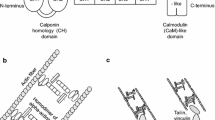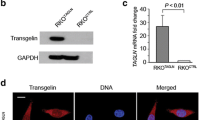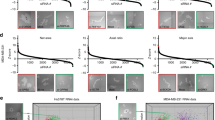Abstract
The AP-1 transcription factor plays a critical role in regulating tumor cell proliferation and has been implicated in controlling a program of gene expression that mediates cell motility and invasion in vitro. We have utilized two dominant negative AP-1 constructs, TAM67 and aFos, each fused to GFP, to investigate the role of AP-1 complexes in an invasive, clinically derived human tumor cell line, HT-1080. As expected, high levels of both GFP-TAM67 and GFP-aFos arrested HT-1080 cells in the G1 phase of the cell cycle. Strikingly, at low levels GFP-aFos, but not GFP-TAM67, caused a change in colony morphology, impairment of directional motility in a monolayer wound healing assay, as well as inhibition of chemotaxis and haptotaxis. Microarray analysis identified a novel set of AP-1 target genes, including the tumor suppressor TSCL-1 and regulators of actin cytoskeletal dynamics, including the gelsolin-like actin capping protein CapG. The demonstration that AP-1 regulates the expression of genes involved in tumor cell motility and cytoskeletal dynamics in a clinically derived human tumor cell line identifies new pathways of control for tumor cell motility.
Similar content being viewed by others
References
Hanahan D, Weinberg RA. Hallmarks of cancer. Cell 2000; 100: 57–70.
Liotta LA, Steeg PS, Stetler-Stevenson WG. Cancer metastasis and angiogenesis: An imbalance of positive and negative regulation. Cell 1991; 64: 327–36.
Rajan R, Vanderslice R, Kapur S et al. Epidermal growth factor promotes chemomigration of a human prostate tumor cell line, and EGF immunoreactive proteins are present at sites of metastasis in the stroma of lymph nodes and medullary bone. Prostate 1996; 28: 1–9.
Karin M, Liu Z, Zandi E. AP-1 Function and Regulation. Curr Op Cell Biol 1997; 9: 240–6.
Curran T, Franza Jr. BR Fos and Jun: The AP-1 Connection. Cell 1988; 55: 395–7.
Pulverer BJ, Kyriakis JM, Avruch J et al. Phosphorylation of c-jun mediated by MAP kinases. Nature 1991; 353: 670–4.
Miner JM, Yamamoto KR. The basic region of AP-1 specifies gluc-ocorticoid receptor activity at a composite response element. Genes Devel 1992; 6: 2491–501.
Bassunk AG, Leiden JM. A Direct physical interaction between ETS and AP-1 transcription factors in normal human T cells. Immunity 1995; 3: 223–37.
Liberati NT, Datto MB, Frederick JP et al. Smads bind directly to the jun family of AP-1 transcription factors. Proc Natl Acad Sci USA 1999; 96: 4844–9.
Sheshedini L, Knauthe R, Sassone-Corsi P et al. Cell specific inhibitory and stimulatory effects of fos and jun on transcription activation by nuclear receptors. EMBO 1991; 10: 3839–49.
Kardassis D, Papakosta P, Pardali K, Moustakas A. c-jun transactivates the promoter of the human p21WAF1/Cip1 gene by acting as a superactivator of the ubiquitous transcription factor Sp1. J Biol Chem 1999; 274: 29572–81.
Kovary K, Bravo R. The jun and fos families are both required for cell cycle progression in fibroblasts. Mol Cell Biol 1991; 11: 4466–72.
Ledwith BJ, Manam S, Kraynak AR et al. Antisense-fos RNA causes partial reversion of the transformed phenotypes induced by the c-Ha-Ras oncogene. Mol Cell Biol 1990; 10: 1545–55.
Ozanne BW, McGarry L, Spence HJ et al. Transcriptional regulation of cell invasion: AP-1 regulation of a multigenic invasion programme. Eur J Cancer 2000; 36: 1640–8.
Hennigan RF, Hawker KL, Ozanne BW. Fostransformation activates genes associated with invasion. Oncogene 1994; 9: 3591–600.
Lamb RF, Hennigan RF, Turnbull K et al. AP-1 Mediated invasion requires increased expression of the hyaluronan receptor CD44. Mol Cell Biol 1997; 17: 963–76.
Spence HJ, Johnston I, Ewart K et al. Krp1, a novel kelch related protein that is involved in pseudopod elongation in transformed cells. Oncogene 2000; 19: 1266–76.
Lamb RF, Ozanne BW, Roy C et al. Essential functional of ezrin in maintainance of cell shape and lamellipodial extension in normal and transformed fibroblasts. Curr Biol 1997; 7: 682–8.
Johnston IM, Spence HJ, Winnie JN et al. Regulation of a multigenic invasion programme by the transcription factor, AP-1: Re-expression of a down-regulated gene, TSC-36, inhibits invasion. Oncogene 2000; 19: 5348–58.
Bos TJ, Margiotta P, Bush L, Wasilenko W. Enhanced cell motility and invasion of chicken embryo fibroblasts in response to Jun over-expression. Int J Cancer 1999; 81: 404–10.
Rinehart-Kim J, Johnston M, Birrer M, Bos T. Alterations in the gene expression profile of MCF-7 breast tumor cells in response to c-Jun. Int. J. Cancer 2000; 88: 180–90.
Reichmann E, Schwarz H, Deiner EM et al. Activation of an inducible c-FosER fusion protein causes loss of epithelial polarity and triggers epitheliai-fibroblastoid cell conversion. Cell 1992; 71: 1103–16.
Fialka I, Schwarz H, Reichmann E et al. The estrogen-dependent c-JunER protein causes a reversible loss of mammary epithelial cell polarity involving a destabilization of adherens junctions. J Cell Biol 1996; 132: 1115–32.
Kustikova O, Kramerov D, Grigorian M et al. Fra-1 induces morphological transformation and increases in vitro invasiveness and motility of epithelioid adenocarcinoma cells. Mol Cell Biol 1998; 18: 7095–105.
Rasheed S, Nelson-Rees WA, Toth EM et al. Characterization of a newly derived human sarcoma cell line (HT-1080). Cancer 1974; 33: 1027–33.
Tanaka K, Iwamoto Y, Ito Y et al. Cyclic AMP regulated synthesis of the tissue inhibitors of metalloproteinases suppresses the invasive potential of the human fibrosarcoma cell line HT1080.Cancer Res 1995; 55: 2927–35.
Paterson H, Reeves R, Brown R et al. Activated N-ras controls the transformed phenotype of HT1080 human fibrosarcoma cells. Cell 1987; 51: 803–12.
Gupta S, Stuffrein S, Plattner R et al. Role of phosphoinositide 3-kinase in the aggressive tumor growth of HT1080 human fibrosarcoma cells. Mol Cell Biol 2001; 21: 5846–56.
Gupta S, Plattner R, Der CJ, Stanbridge EJ. Dissection of Rasdependent signaling pathways controlling aggressive tumor growth of human fibrosarcoma cells: Evidence for a potential novel pathway. Mol Cell Biol 2000; 20: 9294–306.
Anderson MJ, Casey G, Fasching CL, Stanbridge EJ. Evidence that wild-type TP53, and not genes on either chromosome 1 or 11, controls the tumorigenic phenotype of the human fibrosarcoma HT1080. Genes Chromosomes Cancer 1994; 9: 266–81.
Silletti S, Raz A. Autocrine motility factor is a growth factor. Biochem Biophys Res Commun 1993; 194: 446–57.
Hennigan RF, Stambrook PJ. Dominant negative c-jun inhibits activation of the cyclin D1 and cyclin E complexes. Mol Biol Cell 2001; 12: 2352–63.
Dudoit S, Yang Y, Callow MJ, Speed TJ. Statistical methods for identifying differentially expressed genes in replicated cDNA micro-array experiments. Statistica Sinica 2002; 12: 111–39.
Littell RC, Milliken GA, Stroup WW, Wolfinger R. SAS system for mixed models. Carey, North Carolina: SAS Institute 1996.
Wolfinger RD, Gibson G, Wolfinger ED et al. Assessing gene significance from cDNA microarray expression data via mixed models. J Comput Biol 2001; 8: 625–37.
Benjamini Y, Hochberg Y. Controlling the false discovery rate: A practical and powerful approach to multiple testing. J R Stat Soc 1995; B57: 289–300.
Kramer RH, Bensch KG, Wong J. Invasion of reconstituted basement membrane matrix by metastatic human tumor cells. Cancer Res 1986; 46: 1980–9.
Sun H-Q, Kwiatkowska K, Wooten DC, Yin HL. Effects of CapG overexpression on agonist-induced motility and second messenger generation. J Cell Biol 1995; 129: 147–56.
Pollard TD, Borisy GG. Cellular motility driven by assembly and disassembly of actin filaments. Cell 2003; 112: 453–65.
Hirsch DS, Pirone DM, Burbelo PD. A new family of Cdc42 effector proteins, CEPs, function in fibroblast and epithelial cell shape change. J Biol Chem 2001; 276: 875–83.
Li J, Aderem A. MacMARCKS, a novel member of the MARCKS family of protein kinase C substrates. Cell 1992; 70: 791–801.
Kurochkin IV, Yonemitsu N, Funahashi SINH. ALEX1, a novel human armadillo repeat protein that is expressed differentially in normal tissues and carcinomas. Biochem Biophys Res Commun 2003; 280: 340–7.
Pestonjamasp KN, Pope RK, Wulfkuhle JD, Luna EJ. Supervillin (p205): A novel membrane-associated, F-Actin-binding protein in the Villin/Gelsolin superfamily. J Cell Biol 1997; 139: 1255–69.
Masuda M, Yageta M, Fukuhara H et al. The tumor suppressor protein TSLC1 is involved in cell-cell adhesion. J Biol Chem 2002; 277: 31014–9.
Olive M, Krylov D, Echlin DR et al. A dominant negative to activation protein-1 (AP1) that abolishes DNA binding and inhibits oncogenesis. J Biol Chem 1997; 272: 18586–94.
Rutberg SE, Adams TL, Glick A et al. Activator protein 1 transcription factors are fundamental to v-rasHa-induced changes in gene expression in neoplastic keratinocytes. Cancer Res 2000; 60: 6332–8.
Alani R, Brown P, Binetruy B et al. The transactivating domain of c-Jun is required for cotransformation of rat embryo cells. Mol Cell Biol 1991; 11: 6286–95.
Kwiatkowski DJ. Functions of Gelsolin: Motility, signaling, apop-tosis, cancer. Cur Op Cell Biol 1999; 11: 103–8.
Witke W, Li W, Kwiatkowski DJ, Southwick FK. Comparison of CapG and gelsolin-null macrophages: Demonstration of a unique uole for CapG in ueceptormediated ruffeling, phagocytosis, and vesicle rocketing. J Cell Biol 2001; 154: 775–84.
Scott LA, Vass JK, Parkinson EK et al. Invasion of normal human fibroblasts induced by v-Fos is independent of proliferation, immortalization and the tumor suppressors p16 ink4a and p52.Mol Cell Biol 2003; 24: 1540–59.
Author information
Authors and Affiliations
Rights and permissions
About this article
Cite this article
Bahassi, E.M., Karyala, S., Tomlinson, C.R. et al. Critical regulation of genes for tumor cell migration by AP-1. Clin Exp Metastasis 21, 293–304 (2004). https://doi.org/10.1023/B:CLIN.0000046132.46946.dd
Issue Date:
DOI: https://doi.org/10.1023/B:CLIN.0000046132.46946.dd




